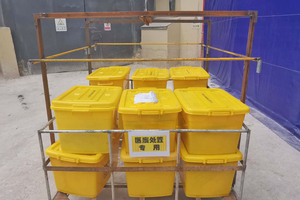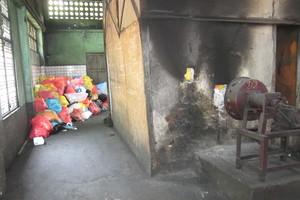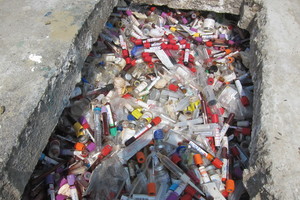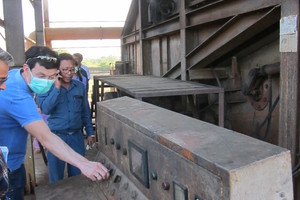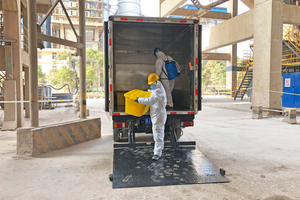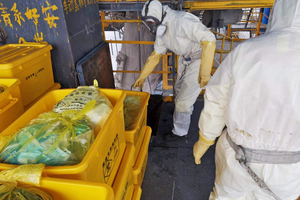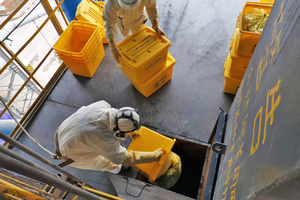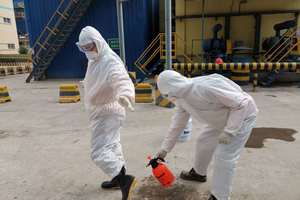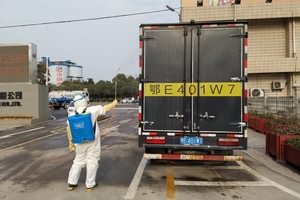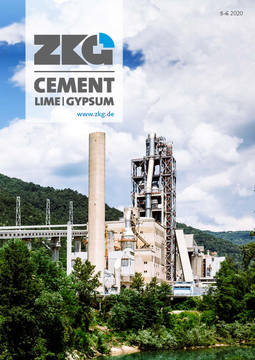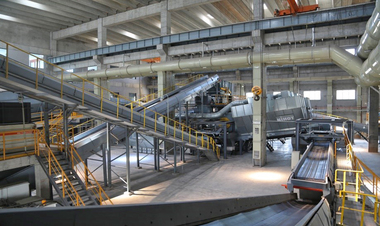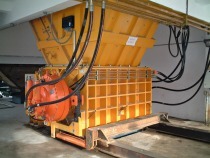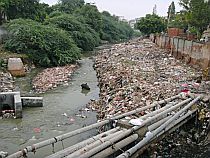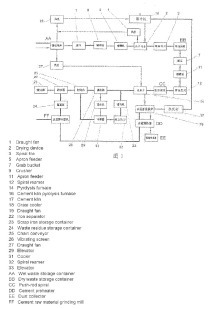Cement industry in China assisted with disposal of Covid-19 healthcare waste
The generation of Covid-19 health care wastes rose by 600% in Wuhan in the middle of the Corona outbreak and there was an urgent need for extra disposal capacity. Huaxin cement reached out and made four of their kilns in Hubei and Yunnan available and disposed of in total 170000 kg of health care wastes like plastic gloves, shields, personal protective equipment and non-infected items.
1 Co-processing in the Chinese cement industry
SINTEF terminated in 2017 a twelve-year project on co-processing of wastes with the Ministry of Ecology and Environment and the Chinese cement industry. The project carried out pilot demonstrations and test burns with many different wastes all over China and contributed to establishing the regulatory and technical foundation for co-processing. When the project started in 2005, only one cement plant had started with initial co-processing – the number of plants practicing co-processing today is more than 100. Tens of millions of tons of wastes have been diverted from landfills and incineration, and millions of tons of coal and virgin raw materials have been saved [5].
The on-going project “Ocean Plastic Turned into an Opportunity in Circular Economy – OPTOCE“ currently investigates how the involvement of energy intensive industries, like cement manufacturing, can increase the treatment capacity for non-recyclable plastic wastes in China, India, Myanmar, Thailand and Vietnam and thereby contribute to the reduction of the release of microplastics to the sea [9, 10, 11]. The five OPTOCE-countries produce an estimated 176000 tonnes of plastic waste every day (64 million t/a) and have some of the highest releases of plastics to the sea. These countries also have the highest production of cement, steel, and electric power, using huge amounts of coal and contributing a large portion of the world‘s greenhouse gas emissions. Replacing parts of this coal with non-recyclable plastic wastes may represent a win-win opportunity – preventing the plastic from ending up in the ocean, reducing the need for fossil coal and indirectly reducing greenhouse gas emissions by avoiding building incinerators or landfills.
The OPTOCE-project aims to carry out pilot demonstrations in local plants in all the five OPTOCE-countries to investigate and document the feasibility, to prove the concept under various local conditions and to uncover any limitations of the practice. One of the current pilots in China is in the Hubei Province where the Corona outbreak started. The Huaxin cement plant in Zigui city is located along the Yangtze River, upstream of the world‘s largest dam, the Three Gorges. The river is draining waste materials from hundreds of millions of people and damaging the turbines at the dam. Floating waste material, including large quantities of plastic is collected and co-processed at the Zigui plant.
Another objective of OPTOCE is to showcase the possibility of treating Covid-19 related health care waste, especially non-recyclable plastic wastes such as gloves, face masks, protective equipment etc.
2 Waste management is essential in the fight to beat Covid-19
With the coronavirus disease (Covid-19) pandemic continuing to spread and its impacts upon human health and the economy intensifying day-by-day, governments are urged to treat waste management as an urgent and essential public service in order to minimise possible secondary impacts upon health and the environment [2].
During such an outbreak, many types of additional health care and hazardous waste are generated, including infected masks and other protective equipment, together with a higher volume of non-infected items of the same nature. Unsound management of this waste could cause unforeseen “knock-on” effects on human health and the environment. The safe handling, and final disposal of this waste is therefore a vital element in an effective emergency response.
Effective management of bio medical and health care waste requires appropriate identification, collection, separation, storage, transportation, treatment and disposal, as well as important associated aspects including disinfection, personnel protection and training. The UN Basel Convention’s Technical Guidelines on the Environmentally Sound Management of Bio Medical and Health Care Wastes, includes information and practical aspects of waste management useful for authorities seeking to minimise hazards to human health and the environment.
Incineration is one important method for the treatment and decontamination of health care waste. Oxidation at high temperature converts the organic compounds into their gaseous oxides, mainly carbon dioxide and water. Inorganic components are mineralized and converted into ash unless they pass into the flue gas. Depending on the type of incinerator, the following objectives can be achieved:
(a) Destruction of pathogens
(b) Reduction of the hazard and pollution
potentials as far as possible
(c) Reduction of volume and quantity
(d) Conversion of remaining residues into a
form which is utilizable or suitable for landfill
(e) Use of the released heat
Hospital waste incinerators are often operated discontinuously, where small volumes of waste are fed in batches at relatively low temperatures, which may lead to poor combustion and inadequate destruction of infectious wastes.
3 Can cement kilns be used to dispose of health care related wastes?
Health care and infectious wastes are usually not accepted by the cement industry, not because they are not capable of destroying such wastes effectively, but due to risk of infections, complicated personnel protection measures and the heterogenous nature of such wastes.
A modern cement kiln has many inherent features, which makes it ideal for hazardous waste treatment; such as high temperatures (1450-2000 °C), long residence time, surplus oxygen during and after combustion, good turbulence and mixing conditions, thermal inertia, counter currently dry scrubbing of the exit gas by alkaline raw material, fixation of the traces of heavy metals in the clinker structure, no generation of by-products such as slag, ashes or liquid residues and close to complete recovery of energy and raw material components in the waste [14, 15, 16, 17, 18].
A stable cement kiln will easily comply with the US TSCA PCB incineration criteria which require a temperature of 1200 °C and 2 seconds retention time at 3% oxygen [6] as well as the EU Directive 2000/76/EU requiring a temperature of 850 °C for at least 2 seconds for the incineration of non-chlorinated hazardous waste and 1100 °C and 2 seconds retention time for organic substances containing more than 1% halogen at 2% oxygen [4].
Both the Stockholm and the Basel Convention recognizes co-processing as a treatment option for hazardous waste and has published „Technical Guidelines on the Environmentally Sound Co-processing of Hazardous Wastes in Cement Kilns“ [1].
4 Treatment of Covid-19 related health care waste in Huaxin Cement, China
The Huaxin cement group was in February asked by the Chinese Government to assist in disposing of wastes related to the Corona outbreak in Wuhan. The volume of hospital and health care wastes rose by 600% in Wuhan in the middle of the outbreak and the normal incineration capacity were not sufficient to dispose of all the wastes (the daily output of waste reached 240 000 kg).
Huaxin cement is one of the larger cement companies in China and has long experience with co-processing of various waste streams in their cement kilns in the Hubei Province and elsewhere in China. In total four of Huaxin‘s kilns disposed of 170 000 kg of health care wastes from February until March.
The wastes were delivered to the plants in 20000 small packages which contained hospital and health care wastes like personal protective equipment, e.g. plastic gloves, shields etc. The wastes were wrapped in two layers, first in plastic bags, then in a hard plastic box, well-sealed.
A code of practice for emergency co-processing of Covid-19 health care waste in cement kilns was published 16 March 2020 by the China Building Materials Federation [3]. This standard prohibits acceptance of wastes containing mercury, explosive ingredients, oxidants, and organic peroxides and requires that the enterprise is equipped with disinfection facilities to disinfect the health care waste transportation vehicles, unloading and conveying facilities, tools, transfer containers (barrels), and the floor of unloading and conveying areas after operation.
The co-processing also had to comply with the Chinese Standard GB30485-2003, “Standard for pollution control on co-processing of solid wastes in cement kilns“ and the HJ662-2013 “Environmental protection technical specification for co-processing of solid wastes in cement kilns“, both published 30 December 2013.
The co-processing was done in four plants, Wuxue and Yangxin with a production of 5000-ton clinker per day, and in the Yidu plant (3500 t/d) and the Zhaotong plant (4500 t/d). The feeding was done manually through a triple valve air-tight flap directly into the high temperature kiln inlet at a rate restricted to 1 ton/hour and 10 hours/day at daytime only, 2 shifts.
In the Hubei province, 110000 kg from the city of Huanggang were disposed of in the Wuxue plant, 50000 kg from Wuhan in the Yangxin plant, 5000 kg from Yidu city in the Yidu plant. In Yunnan province, 6000 kg from the city of Zhaotong were disposed of in the Zhaotong plant. All the plants were operated at normal production capacity, fired with coal and co-processing RDF.
5 Conclusion
The generation of Covid-19 health care wastes rose by 600% in Wuhan in the middle of the Corona outbreak and there was an urgent need for extra disposal capacity. Huaxin cement reached out and made four of their kilns in Hubei and Yunnan available and disposed of in total 170000 kg of health care wastes like plastic gloves, shields, personal protective equipment and non-infected items.
A code of practice for co-processing of Covid-19 health care waste in cement kilns was followed and no accidents happened – no impact could be identified on the emissions or the product quality during the co-processing. An independent pilot demonstration should be conducted to verify the plants performance prior to a larger or permanent health care waste disposal operation.
//www.sintef.no" target="_blank" >www.sintef.no:www.sintef.no | //www.huaxincem.com" target="_blank" >www.huaxincem.com:www.huaxincem.com

